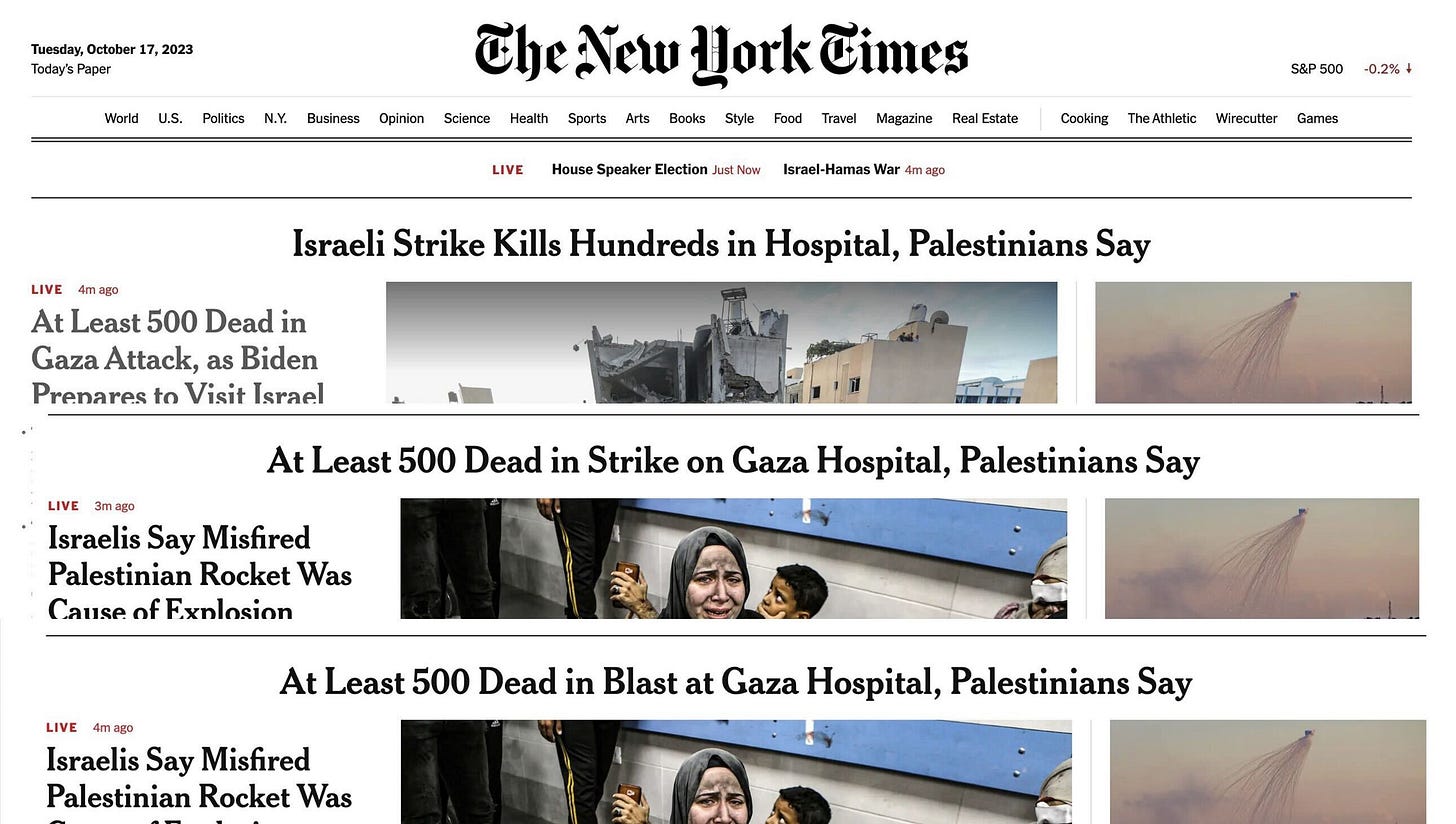NYT Uses Photo of Wrong Location for Hospital Story
The fog of war leads to some very shoddy reporting, as media outlets favor speed over accuracy.
As I and many others critically pointed out, news stories about the Palestinian hospital explosion initially reported, without verification, that it was the result of an Israeli airstrike.
The Free Press has a good image illustrating the New York Times’s evolving headline, as reports subsequently came in that the the explosion may have been caused not by Israel but by the misfire of a Palestinian rocket:
There are some highly technical threads on the evidence about the origin of the explosion. And this Wall Street Journal article delves into the details. NBC News reported on Wednesday that “The U.S. has an independent assessment that it was Palestinian Islamic Jihad rocket that misfired and hit the hospital in Gaza, according to two senior U.S. officials.”
I’m fully comfortable saying that as of this writing the origin of the explosion is inconclusive or conflicting. This is deeply problematic, given that the Times, the AP, and many other outlets immediately, credulously reported claims from Palestinian authorities that it was the result of an Israeli airstrike.
A second problem with this reporting, which hasn’t gotten as much attention, is the image the New York Times used to accompany its initial story on the hospital:
The blown up hospital makes for an arresting image, sure to grab readers. As Susan Sontag wrote in “Regarding the Pain of Others,” these types of violent images are alluring, and even pornographic. “Everyone knows that what slows down highway traffic going past a horrendous car crash is not only curiosity,” she wrote. “It is also, for many, the wish to see something gruesome.”
If you look closely, though, the white text on the image says that the photograph of the bombed building is actually in Khan Younis. It is not of the hospital in Gaza City. Yet, of course, the juxtaposition of this image under the screaming headline implies that this is the damaged hospital.
Another image from the Times, used in its tweet for the article, presumably seen by many thousands of people, doesn’t even have a caption indicating it’s from another location:
Is there anyone who thinks it’s appropriate for an image from one location to be used to accompany a story about a different location?
The Times today has another article on the hospital. Notice the caption:
PBS also used the phrase “at least 500 killed” in its headline. Yet, the WSJ article about the origin of the explosion, updated today, called into question the death toll claimed by the Palestinian authorities. “The amount of damage also appears inconsistent with the Hamas-controlled Gaza Health Ministry’s assertion that 471 people were killed, experts said.” Either way, note that the number claimed by the Ministry was 471. Al Jazeera also reported this number.
So, 1) How did “471” turn into “At least 500” in the NYT and PBS reporting?
And 2) It’s possible the death toll may be—thankfully—far below 471.
From my years as a fact checker at Conde Nast magazines, one of the rules we had to follow was not only to make sure that attribution of a quote or statement was correct, but that the content in the statement itself was correct. News outlets failed to do this.
In the rush to be first, or simply to be in the pack with each new development, major media outlets, that the public is supposed to trust, are repeatedly getting key details wrong. Many readers may not see the follow-up headlines or revised numbers or correct images. Instead, they’ll remember that “at least 500 died” as the result of an “Israeli strike,” and picture in their minds the image of a bombed-out building, erroneously thinking that it was the hospital.










I love this analysis. One nit I have is that the caption does not say the photo is not the hospital. It just describes it and only in “above” is the connection made that the photo isn’t the intended impression.
I grew up in the DC area and the WaPo & NYT were staples at my parents’ home. As I returned to my parents home through out the years, I could no longer read either paper due to their morphing from “Newspapers” to propaganda mouthpieces for the progressive movement.
I do remember the time when “news” was exactly that and you did not have to fact check the news outlets. Unfortunately, those days are long gone.
Looking forward to the day when WaPo joins the Washington Star in the graveyard of “news” publications, with the NYT, close behind.